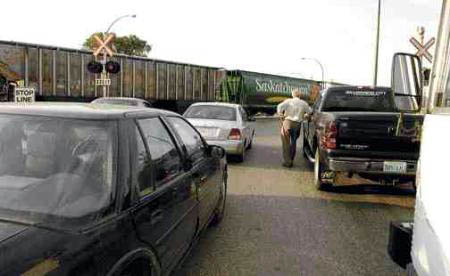
24 May 2008
Atchison Wants Trains Out of City

Traffic was tied up 4 Sep 2007 when a train was
forced to stop while travelling through the city.
 Saskatoon Saskatchewan - The Canadian Pacific rail line
helped make Saskatoon a boomtown 100 years ago, but now its presence in the core may be stifling downtown growth, says Mayor Don
Atchison.
Saskatoon Saskatchewan - The Canadian Pacific rail line
helped make Saskatoon a boomtown 100 years ago, but now its presence in the core may be stifling downtown growth, says Mayor Don
Atchison.
"I know they were here first, but we need to get them out of the city," Atchison said in an interview.
The mayor's irritation with railways has been building in recent years. Atchison blames a lack of co-operation from CP for
the fact the city hasn't yet extended 25th Street from First Avenue to Idylwyld Drive. Car-switching between CP and
Canadian National downtown is a major impediment to what could become a long-awaited redevelopment of the nearby city
yards.
And Atchison said he doesn't want to see downtown traffic gridlocked again, as it was 4 Sep 2007, due to a stalled
two-kilometre-long CP train.
"That speaks to the situation that things have to change," Atchison said.
Saskatoon was faced in the 1960s with a choice between economic development and keeping a downtown rail line. Ultimately, CN moved its
rail operations from the present-day site of Midtown Plaza to the Chappell Yards south of Montgomery Place. The city's
original north-south rail line pulled out of downtown, allowing construction to start in 1964 of the Idylwyld Freeway,
said city archivist Jeff O'Brien. Six years later, CN's former downtown rail station opened to shoppers.
Saskatoon still benefits greatly from having major rail lines, said city manager Phil Richards. Commodities are increasingly moving by
containers. As an exporting province, Saskatchewan can't afford its cities to be too far away from rail lines.
"That we're on the main (CN) line is a big plus for all of us," Richards said.
The problem is where those strands of rail stretch across the city map.
RAILWAYS ON THE EDGE
The city's long-term goal is to see both railway companies abandon their lines within Saskatoon for new routes on the
periphery. Trains may be a longtime economic driver for cities, but they can clash with street traffic and residential development.
City crossings are carefully managed to limit risk, but there's no way to eliminate all danger.
Moving the railways could be "extraordinarily positive" for Saskatoon, said Kent Smith-Windsor, executive
director of Greater Saskatoon Chamber of Commerce. Sutherland alone would likely see major commercial development fill in the land now
occupied by the CP yards, he said.
The downside of moving is that some north industrial businesses, as well as the Robin Hood mill, need rail access. Any change in the
urban rail system would have to include a solution for them, he said.
ON THE RIGHT TRACK
Saskatoon is one of many Canadian cities interested in moving rail lines to the periphery, although it rarely happens, said Barry
Prentice, a professor at University of Manitoba's Transport Institute.
"I think the mayor is on the right track. You don't think about strategic planning next year. (Think) where are we going to be 30,
40, 50 years from now?"
Moving out of cities holds advantages for railway companies, too, Prentice said.
Local businesses have less need for deliveries by rail car than they did a few decades ago. Most rail activity in Prairie cities
involves switching cars, or trains loaded with containers running right through.
A more rural location would likely save rail companies property taxes, allow them to sell prime city real estate, and enable trains to
run at higher speeds, improving times and reducing maintenance, Prentice said.
"Why do we need tracks through the downtown is the question mark. Or for that matter, why do we need rail tracks at all in most of
the city?"
CP isn't saying no to the idea of moving out.
"At this time we don't have any intention of moving our operations out of Saskatoon," said CP spokesperson Breanne Feigel.
"That said, we're always open to hear others' ideas. But it's a discussion that needs to happen not through the media."
Moving the CP line would take co-operation and cost-sharing among all levels of government, she said.
"This idea would be extremely expensive and a fairly complex plan. It wouldn't be solely a CP decision," Feigel said.
If it's the city pushing for CP to relocate, taxpayers would likely bear a big share of the costs of buying land and gaining
environmental approvals, Prentice said. Cleanup costs from 100 years of rail operations might be considerable, he added.
SHORT-TERM SOLUTIONS
The city's pressing goal is to work out an agreement this summer with the railways to allow an extended 25th Street to cross two sets
of tracks. Related to that are talks to halt the daily car-switching between CN and CP near First Avenue and King Street.
Talks with CP on a crossing agreement for 25th have dragged on for several years, Atchison said.
"We can't get that co-operation," he said. "We need to get this project done. It completes the downtown.
This can't continue to drag on."
Extending 25th is expected to spur development in the warehouse district. It gives downtown a neat northern boundary, easing traffic
flow, and creates a direct route through downtown from Highway 5.
The agreement isn't as simple to work out as it may appear, said Murray Totland, the city's man at the negotiating table. Designing a
safe crossing of trains and vehicles takes planning, co-ordination, and dollars. But he's confident both sides want to get
there.
"I don't think CP wants to stall the project," said Totland, the city's general manager of infrastructure services.
The city is proposing a diagonal, at-grade crossing of vehicles and trains. CP wants the city to move cars through an
overpass, said Feigel.
"CP continues to have safety concerns with all the proposed intersection designs," Feigel said. "This type of diagonal
crossing is fairly dangerous for motorists. There are only a handful of these crossings in Canada."
CN also enters the discussions because 25th would cross its short spur line where it parks rail cars until they're switched. Once the
city and railways agree, extending 25th would take two years to complete and cost $6.8 million.
Switching of rail cars poses one of the biggest impediments to redeveloping the city yards - downtown's next biggest development
opportunity after River Landing.
The city is studying the costs and benefits of moving its equipment out of the yards, north of 25th Street, to a new, undetermined site
near Circle Drive with the Caswell Hill bus barns. Once the study is done, the city would need to assess environmental damage from
close to a century of rail and heavy equipment use on the site, Richards said.
New homes and businesses could fill in the gap, injecting life into north downtown. Richards said optimistically it could all happen in
five to 10 years.
None of it is likely if the rail-car interchange stays.
"Ultimately, I think both ourselves and both railways would love to get that operation out of downtown altogether," Totland
said. "We're trying to talk with them about that: Instead of trying to squeeze this in somewhere downtown, could you look at
doing this whole operation somewhere else?"
CP is willing to consider moving its switching operations to a new location. But it runs five evening trains per week into downtown to
serve local business customers.
"We're not willing to compromise our operations with our customers," Feigel said.
CN spokesperson Kevin Franchuk would not comment on negotiations with the city except to say they are ongoing. He would not discuss the
logistical challenges of finding a new site to switch cars with CP.
Impatient Pedestrians Made Problem Worse
So why were you waiting hours in downtown traffic on 4 Sep 2007 while a CP train was stopped in its tracks?
Part of the blame falls on pedestrians, said CP spokesperson Breanne Feigel.
A two-kilometre-long freight train ground to a halt in downtown that day due to faulty equipment. The train blocked
numerous intersections, paralyzing rush-hour traffic.
The train had a mechanical problem, but it also couldn't unlock cars at crossings because of locked brakes, Feigel said.
CP mechanics got the part they needed and fixed the problem within an hour. It took considerably longer to move the train, however.
"The added delay was caused by impatient pedestrians who were climbing over and under the train and boxcars," she said.
"There was no way our crews had any interest in starting that train until they knew it was safe to do so."
That meant walking up and down beside a train more than 100 cars long checking for pedestrians.
Contrary to reports at the time, Transport Canada didn't order CP to write a corrective action plan, Feigel said. The federal
department asked for CP's safety measures and a summary of steps it took.
"They were satisfied with that."
CP has submitted its safety guidelines, confirmed Transport Canada spokesperson Jacqueline Petrus. She would not offer details on any
further discussions with the railway company.
|